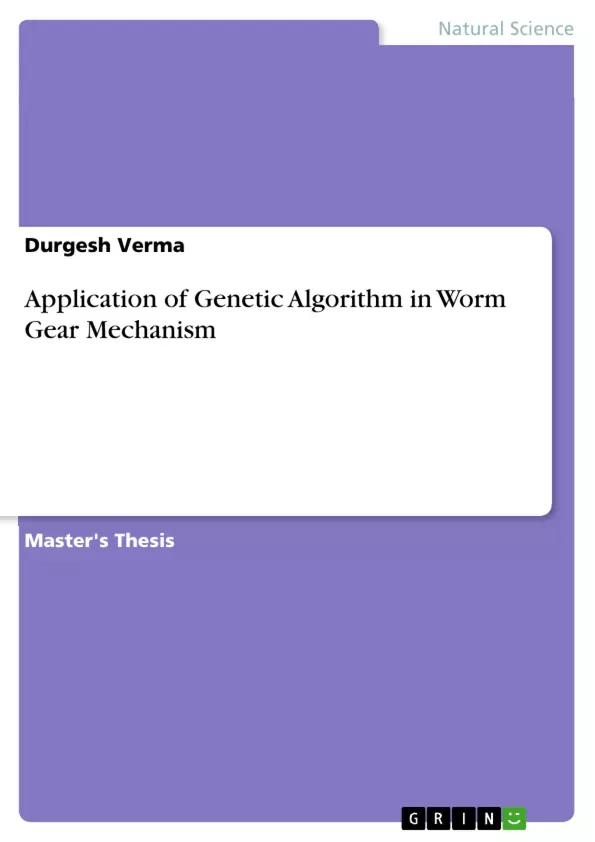In this study, a foundation and solution technique using Genetic Algorithm (GA) for design optimization of worm gear mechanism is presented for the minimization of power-loss of worm gear mechanism with respect to specified set of constraints.
Number of gear tooth and helix (thread) angle of worm are used as design variables and linear pressure, bending strength of tooth and deformation of worm are set as constraints.
The GA in Non-Traditional method is useful and applicable for optimization of mechanical component design. The GA is an efficient search method which is inspired from natural genetics selection process to explore a given search space.
In this work, GA is applied to minimize the power loss of worm gear which is subjected to constraints linear pressure, bending strength of tooth and deformation of worm.
Up to now, many numerical optimization algorithms such as GA, Simulated Annealing, Ant-Colony Optimization, Neural Network have been developed and used for design optimization of engineering problems to find optimum design. Solving engineering problems can be complex and a time consuming process when there are large numbers of design variables and constraints. Hence, there is a need for more efficient and reliable algorithms that solve such problems. The improvement of faster computer has given chance for more robust and efficient optimization methods. Genetic algorithm is one of these methods. The genetic algorithm is a search technique based on the idea of natural selection and genetics.
Inhaltsverzeichnis (Table of Contents)
- OVERVIEW
- Preamble
- Background of the work
- Genetic Algorithm Techniques
- Performance
- Features of GA
- Representation
- Working Principles
- Coding
- Fitness Function
- GA Operators
- Selection: Roulette Wheel
- Overview of present work
- GA Operators
- Tournament Selection
- Specification of Problem
- Mathematical model for Analysis
- Objectiv Funktion
- Design Variables
- Constraints
- The Basic GA
- LITERATURE REVIEW
- Flight Trajectory Optimization using GA
- Optimal Pump Operation of water distribution systems using GA
- Penalty function methods for constrained optimization with GAS
- A Real Coded GA for optimization of cutting parameters in turning
- Optimization of production planning in a Real world manufacturing environment
- DEVELOPMENT OF NON-TRADITIONAL SEARCH
- Introduction
- Brief history of non-traditional optimization methods
- Ant-Colony Optimization
- Neural Network
- Simulated Annealing
- Proposed Non-Traditional Optimization Search Technique
- Introduction
- Benefits of GAs
Zielsetzung und Themenschwerpunkte (Objectives and Key Themes)
This work focuses on the application of Genetic Algorithm (GA) in the design and optimization of worm gear mechanisms. The primary goal is to explore the potential of GA as a powerful tool for solving complex engineering problems, specifically in the context of worm gear design.
- Application of Genetic Algorithms in Mechanical Engineering
- Optimization of Worm Gear Mechanisms
- Non-Traditional Optimization Techniques
- Performance and Efficiency of Worm Gear Systems
- Design Variables and Constraints in Worm Gear Design
Zusammenfassung der Kapitel (Chapter Summaries)
- OVERVIEW: This chapter provides an introduction to the topic of Genetic Algorithms (GA) and their applications in engineering. It discusses the fundamental principles of GA, including its working principles, representation, coding, fitness function, and GA operators. It also introduces the specific problem of optimizing worm gear mechanisms and outlines the key aspects of the research project.
- LITERATURE REVIEW: This chapter explores existing literature on the application of Genetic Algorithms in various engineering domains, focusing on their use in optimization problems. It reviews case studies involving GA-based solutions for flight trajectory optimization, water distribution system optimization, constrained optimization with GA, and cutting parameter optimization in turning. It also examines the optimization of production planning in a real-world manufacturing environment.
- DEVELOPMENT OF NON-TRADITIONAL SEARCH: This chapter delves into non-traditional optimization methods beyond Genetic Algorithms. It provides a brief historical overview of alternative approaches like Ant-Colony Optimization, Neural Networks, and Simulated Annealing. It then focuses on the proposed non-traditional optimization search technique, highlighting the benefits of using Genetic Algorithms in this context.
Schlüsselwörter (Keywords)
This work primarily explores the use of Genetic Algorithms (GA) for optimizing worm gear mechanisms in mechanical engineering. Key concepts include non-traditional optimization methods, performance analysis, design variables, constraints, and efficiency of worm gear systems.
- Quote paper
- Dr. Durgesh Verma (Author), 2010, Application of Genetic Algorithm in Worm Gear Mechanism, Munich, GRIN Verlag, https://www.grin.com/document/208547



